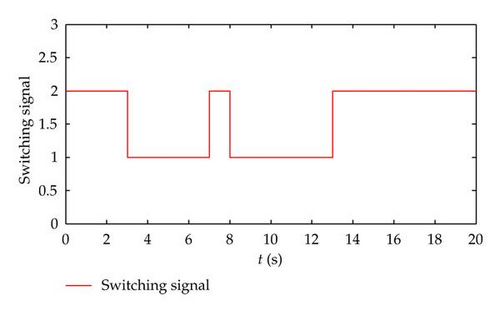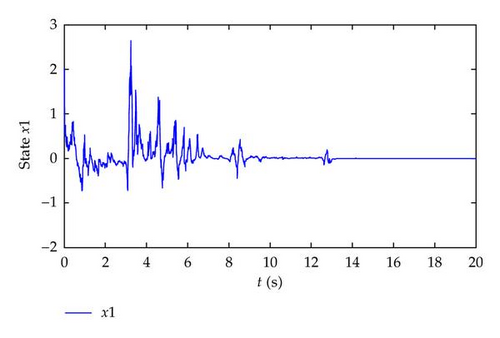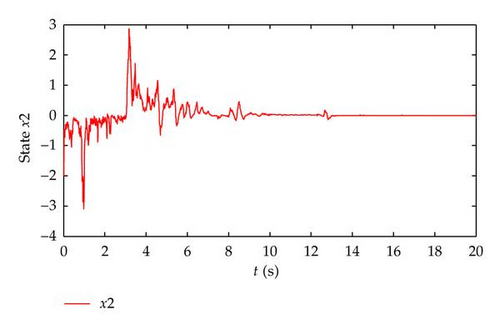Stability Analysis and Robust H∞ Control of Switched Stochastic Systems with Time-Varying Delay
Abstract
The problems of mean-square exponential stability and robust H∞ control of switched stochastic systems with time-varying delay are investigated in this paper. Based on the average dwell time method and Gronwall-Bellman inequality, a new mean-square exponential stability criterion of such system is derived in terms of linear matrix inequalities (LMIs). Then, H∞ performance is studied and robust H∞ controller is designed. Finally, a numerical example is given to illustrate the effectiveness of the proposed approach.
1. Introduction
Switched systems, a special hybrid system, are composed of a set of continuous-time or discrete-time subsystems and a rule orchestrating the switching between the subsystems. In the last two decades, there has been increasing interest in the stability analysis and control design for such switched systems since many real-world systems such as chemical systems [1], robot control systems [2], traffic systems [3], and networked control systems [4, 5] can be modeled as such systems. The past decades have witnessed an enormous interest in the stability analysis and control synthesis of switched systems [6–11].
It is well known that time delay phenomenon exists in many engineering systems such as networked systems and long-distance transportation systems. Such phenomenon may cause the system unstable if it cannot be handled properly, which motivates many scientists to involve themselves in researching switched systems with time delay. Many results have been reported for stability analysis of switched systems with time delay [12, 13], where the asymptotical stability criteria are given by using common Lyapunov function approach in [12], and the exponential stability criteria under average dwell time switching signals are proposed in [13]. Moreover, the problem of delay-dependent global robust asymptotic stability of switched uncertain Hopfield neural networks with time delay in the leakage term is discussed in [14]. H∞ control of continuous-time switched systems with time delay and discrete-time switched systems with time delay are investigated in [15, 16], respectively.
On the other hand, stochastic systems have attracted considerable attention during the past decades because stochastic disturbance exists in many actual operations. Many useful results on the stability analysis of stochastic systems are reported in [17–21]. The problem of robust H∞ control for nonlinear stochastic systems with Markovian jump parameters and interval time-varying delays is considered [22]. Based on the results of stochastic systems and switched systems, the stability analysis and stabilization of switched stochastic systems are investigated in [23, 24]. Furthermore, the problems of reliable control and reliable H∞ control for switched stochastic systems under asynchronous switching are studied in [25, 26], respectively. Recently, these results are extended to stochastic switched systems with time delay, and the exponential stability criteria are addressed [27, 28]. However, these results are very complex, which make it more difficult for us to solve many issues such as controller design under asynchronous switching and actuator failures. Therefore, there is a lot of work to do in such field. This motivates the present study.
In this paper, we focus on the mean-square exponential stability analysis and robust H∞ control of switched stochastic systems with time-varying delay. Based on the average dwell time method and Gronwall-Bellman inequality, a new mean-square exponential stability criterion is derived. Moreover, H∞ performance is studied and H∞ state feedback controller is proposed. The remainder of the paper is organized as follows. In Section 2, problem statement and some useful lemmas are given. In Section 3, based on the average dwell time method and Gronwall-Bellman inequality, the mean-square exponential stability and H∞ performance of the switched stochastic systems with time delay are investigated. Then, robust H∞ controller is designed. In Section 4, a numerical example is given to illustrate the effectiveness of the proposed approach. Finally, concluding remarks are provided in Section 5.
Notation. Throughout this paper, the superscript ‘‘T’’ denotes the transpose, and the symmetric terms in a matrices are denoted by ∗. The notation X > Y(X ≥ Y) means that matrix X − Y is positive definite (positive semidefinite, resp.). Rn denotes the n dimensional Euclidean space. ∥x(t)∥ denotes the Euclidean norm. L2[t0, ∞) is the space of square integrable functions on [t0, ∞). λmax (P) and λmin (P) denote the maximum and minimum eigenvalues of matrix P, respectively. I is an identity matrix with appropriate dimension. diag {ai} denotes diagonal matrix with the diagonal elements ai, i = 1,2, …, n.
2. Problem Formulation and Preliminaries
Definition 2.1. System (2.1) is said to be mean-square exponentially stable with under switching signal σ(t), if there exist scalars κ > 0 and α > 0, such that the solution x(t) of system (2.1) satisfies , for all t > t0. Moreover, α is called the decay rate.
Definition 2.2. For any T2 > T1 ≥ t0, let Nσ(T1, T2) denote the switching number of σ(t) on an interval (T1, T2). If
Definition 2.3. Let γ > 0 be a positive constant, for system (2.1), if there exists a controller u(t) and a switching signal σ(t), such that
- (1)
when v(t) = 0, system (2.1) is mean-square exponentially stable;
- (2)
under zero initial condition x(t) = 0, t ∈ [t0 − h, t0], the output z(t) satisfies
The following lemmas play an important role in the later development.
Lemma 2.4 (see [29] Gronwall-Bellman Inequality.)Let x(t) and y(t) be real-valued nonnegative continuous functions with domain {t∣t ≥ t0}; a is a nonnegative scalar; if the following inequality
Lemma 2.5 (see [30].)Let U, V, W, and X be constant matrices of appropriate dimensions with X satisfying X = XT, then for all VTV ≤ I, X + UVW + WTVTUT < 0, if and only if there exists a scalar ε > 0 such that X + εUUT + ε−1WTW < 0.
3. Main Results
3.1. Stability Analysis
In this subsection, we will focus on the exponential stability analysis of switched stochastic systems with time-varying delay.
Theorem 3.1. Considering system (3.1), for a given scalar α > 0, if there exist symmetric positive definite matrices Pi, Qi > 0 satisfying
Proof. Consider the following Lyapunov functional for the ith subsystem:
According to Itô formula, along the trajectory of system (3.1), we have
The proof is completed.
Remark 3.2. The exponential stability criterion of stochastic switched systems with time-varying delay is given in Theorem 3.1. When w(t) = 0, system (3.1) is degenerated to the switched system with time-varying delay, which can be described as
3.2. H∞ Performance Analysis
In this subsection, we will investigate the H∞ performance of switched stochastic systems with time-varying delay.
Theorem 3.4. Considering system (3.21), for a given scalar α > 0, if there exist symmetric positive definite matrices Pi, Qi > 0 such that
Proof. By Theorem 3.1, we can readily obtain that system (3.21) is mean-square exponential stable when v(t) = 0.
Assume that the ith subsystem is activated during [tk, tk+1). Choose the following Lyapunov functional candidate for the ith subsystem:
Remark 3.5. When dw(t) = 0, system (3.21) is reduced to a switched delay system, which can be described as
3.3. Design of Robust H∞ Controller
Theorem 3.7. Considering system (2.1), for given scalars α, εi > 0, hd < 1, if there exist matrix Zi, symmetric positive definite matrices Xi, Yi> 0 such that
Proof. By Theorem 3.4, system (3.43) is mean-square exponentially stable with weighted H∞ performance γ if the following inequalities are satisfied:
Then using to pre- and postmultiply Λi, we have
Furthermore,
Combining (3.51) with (2.4), we have
Moreover,
The proof is completed.
Remark 3.8. Theorem 3.4 presents the sufficient conditions which could guarantee that the switched stochastic delay system is stable with H∞ performance; when the robust H∞ control problem is considered, we can solve the problem by substituting the closed-loop uncertain parameters , , to Theorem 3.4.
4. Numerical Example
Simulation results are shown in Figures 1–3, where the initial state x(t) = [0,0] T, t ∈ [−h, 0), and x(0) = [2,−2]T. The switching signal with the average dwell time Tα = 4 is shown in Figure 1, and Figures 2 and 3 show state x1 and x2 of the closed-loop system, respectively.



5. Conclusions
In this paper, the exponential stability analysis and robust H∞ control for switched stochastic time delay systems have been investigated. Based on the average dwell time method and Gronwall-Bellman inequality, a new mean-square exponential stability criteria and H∞ performance analysis are presented. Furthermore, robust H∞ controller is designed to guarantee that the corresponding closed-loop system is mean-square exponentially stable. Finally, a numerical example is given to illustrate the effectiveness of the proposed approach. The proposed method provides a powerful tool to solve many other problems such as controller design under asynchronous switching and actuator failures. These problems are the topics of the future research.
Acknowledgments
This work was supported by the National Natural Science Foundation of China under Grant no. 60974027 and NUST Research Funding (2011YBXM26).




